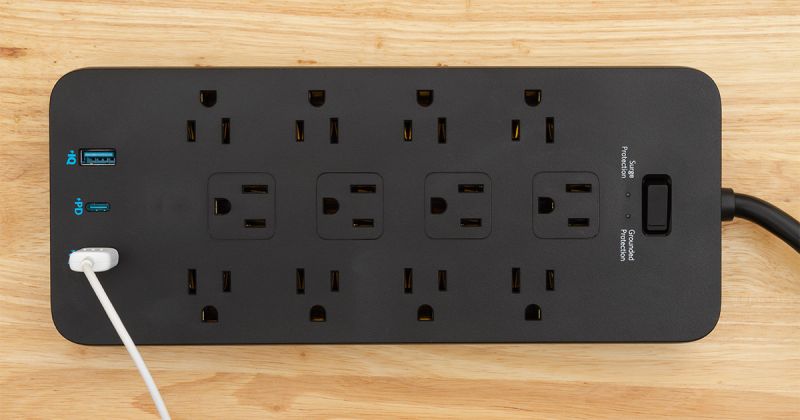
Understanding the Effectiveness of Surge Protectors?
Do you protect your Tallahassee-area home’s appliances and electronic devices with a surge protector? Did you know that electrical power surges are the leading cause of damage to electronic devices and equipment in homes and businesses? Does your home have a whole-house surge protector? Do you know the difference between a power strip and a surge protector?
If you answered “no” or “you don’t know”, read on to learn about electrical power surges and how surge protectors serve as crucial barriers against the damaging high voltages that a surge can deliver into your home’s electronics. To ensure optimal protection for your home electronics, contact a professional electrician—like the professionals at Tallahassee’s Meeks Electrical Services—to install a whole-house surge protector.
What to Know About Electrical Power Surges
A power surge is a brief spike in electrical voltage that exceeds the standard 120 volts delivered into homes. A major surge, like one induced by a nearby lightning strike, can send thousands of volts into the home, where the excess electrical energy can cause extensive damage to electronics. Even minor surges can strain electrical components, causing them to wear out and decreasing the lifespan of the device or appliance. Fortunately, highly damaging lightning-strike-induced surges are relatively rare compared to other sources of power surges, like:
- Downed power lines.
- Restoration of electrical power after an outage.
- In-home cycling of high-power household appliances like air conditioners and refrigerators.
- Faulty home wiring.
- Significant changes in electricity demand from nearby industrial facilities or other high-capacity users.
Surge Protectors Divert Power Surges to Ground
All surge protectors work by diverting excess voltage to ground while allowing the steady delivery of standard voltage levels to devices plugged into the protector. Most plug-in single-circuit and whole-home surge protectors use a metal oxide varistor (MOV) to connect the hot wire within the protector to a grounding line. When voltages exceed standard levels, semiconductors within the MOV naturally conduct the excess current to the grounding wire. Many surge protectors also include a fail-safe built-in fuse that completely cuts the circuit if the MOV is unable to handle all excess voltage.
The Difference Between Power Strips and Surge Protectors
The surge protectors and power strips that plug into an outlet to power several devices appear very similar. However, while all surge protectors are also power strips, not all power strips are surge protectors. Power strips work as an extension cord with multiple outlets and sometimes a switch to quickly cut the power to connected devices. That switch will not protect against a surge and connecting a device to a power strip is just like plugging it into the wall in terms of electrical safety.
To determine whether your home electronics are connected via a power strip or surge protector look first for a “Protection” light that should glow when plugged into the outlet. If there is no light, read the fine print on the back of the strip to see whether it references a suppressed voltage rating or anything referring to protection or suppression. If not, then it’s a simple power strip. If the light doesn’t glow when plugged in, your surge protector no longer works because the semiconductors have burned out or other components have failed.
Surge Protector Effectiveness
The effectiveness of a surge protector depends on numerous factors, and whole-house surge protectors generally provide far more protection than single-circuit ones. Professionally installed directly on the home’s electrical panel, whole-house surge protectors can typically handle most power surges. However, a whole-house protector may not be able to handle all excess voltage, especially in the event of a nearby lightning strike. Thus, for greater peace of mind, electricians recommend that homeowners also use single-circuit surge protectors, particularly for computer equipment, home theater systems, and other sensitive electronics.
A professional electrician can advise you on the best whole-house surge protection for your home. When picking out single-circuit surge protectors, you can assess their effectiveness by several features, including:
- UL (Underwriters Laboratory) 1449 certification.
- Fast, less-than-a-nanosecond response times.
- Low clamping voltage (threshold at which protector begins diverting excess voltage).
- Minimum 600 Joule or greater rating (indicates ability to absorb surges over time).
- Indicator lighting that signals proper functioning and provides alerts on surge protection given.
Another type of single-circuit surge protector to consider is an uninterruptible power supply (UPS). These protectors offer outstanding protection for sensitive electronics and provide temporary backup power during outages to allow time for a safe shutdown.
Contact Meeks Electrical for Your Whole-Home Surge Protection
To give your home electronics the best protection for electrical power surges, contact the experts at Meek’s Electrical for installation of whole-home surge protection. With 50-plus years of delivering top-notch home electrical services in Tallahassee and Leon County, we can ensure the best in your home’s electrical safety. To learn more, contact us at (850) 575-5241.